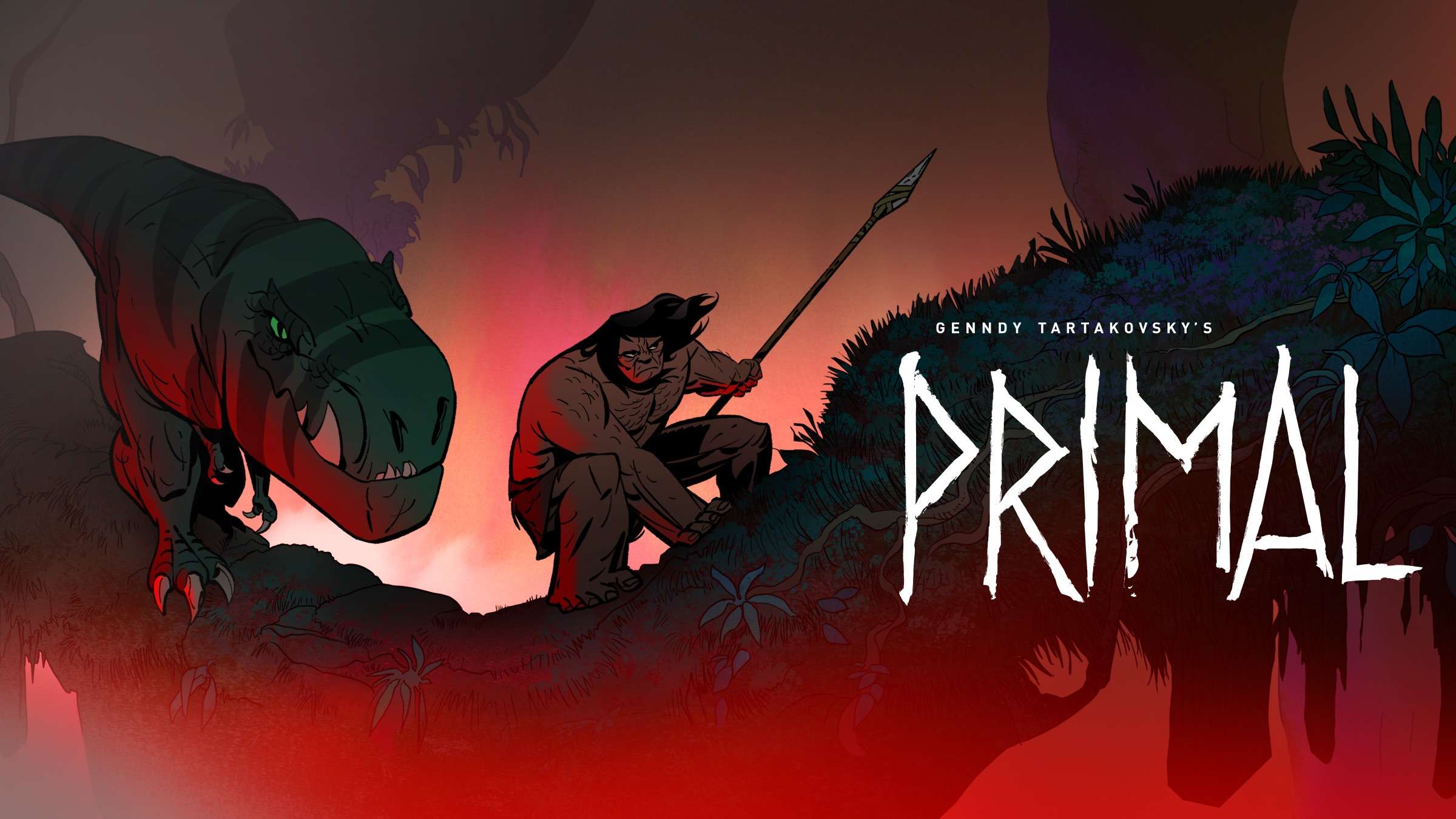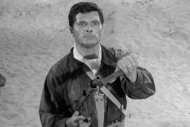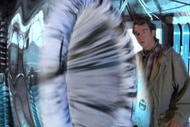Create a free profile to get unlimited access to exclusive videos, sweepstakes, and more!
Genndy Tartakovsky sets the stage for game-changing Primal stories, and explains a Samurai Jack surprise

It’s been a year since Genndy Tartakovsky’s Primal left audiences with one hell of a dino-sized cliffhanger. In “Rage of the Ape-Men,” the unlikely (and scientifically impossible, but go with it) prehistoric team of Neanderthal man, Spear, and his tyrannosaurid traveling companion, Fang, were forced into a primordial gladiator-esque fight to the death against ape-like men. The episode faded to black with a mortally wounded Fang as a devastated Spear looked on helplessly at her prone body.
On Sunday, Oct. 4, Genndy Tartakovsky’s Primal will resolve the story with the new episode “Scent of Prey,” and four more new chapters to close out the first season of Adult Swim’s R-rated, 2D animated series. And while we’ve been waiting, Tartakovsky and his Primal team earned three 2020 Outstanding Individual Achievement in Animation Juried Emmy Awards for the first half of the season and a network pick-up order for Season 2.
SYFY WIRE recently caught up with Tartakovsky regarding the return of Primal and he shared that the Emmy wins were unexpected validation for what is an admittedly "out there" premise for an animated series. “It always feels good to get recognized for something that not only did we believe in, but we love and we put our everything in it. But even from the early days of Dexter's Laboratory through Samurai Jack and Sym-Bionic Titan, I never know what anybody's really going to think, or like,” he admits. “I always believe that if you do something sincerely and with quality, you'll get an audience. And Primal is exactly what I love and what I want to see.”
The series is also one-of-a-kind in the current animation landscape, with its hard-R depiction of violence, a traditional animation look, and an utter lack of dialogue in every episode. You’d be hard-pressed to find anything even slightly similar going back all the way to animator Ralph Bakshi’s work in the late '70s.
“There was no adult market,” Tartakovsky confirms. “And now the comedy/adult market is explosive, right? Probably one of the hottest things that everybody wants, where you even build a network around it. But we're still very much taking our baby steps right now.”
Luckily, Tartakovsky and company are doing it largely unimpeded, with Adult Swim so supportive of their output that the series has remained very much his pure vision. "It's pretty much myself, and then [executive producer and former EVP of Adult Swim Programming] Mike Lazzo, who kind of approves it, and that's about it. You know, I'm from 2D and my goal was to be an animator. And so, to do 2D animation of this quality and this subject matter for adults is an achievement and a dream come true, really.”
With production on Genndy Tartakovsky’s Primal Season 2 currently happening, we got Tartakovsky to delve into the rest of Season 1, where he’s taking Season 2, and even explain how an alternative ending for Samurai Jack Season 5 ended up in the recently released Samurai Jack: Battle Through Time video game.
You left audiences with a massive Primal cliffhanger. Was Season 1 constructed knowing there would be a long break?
We never planned for there to be a break in between episodes five and six. We thought it was going to be like a week break. But because the show takes a long time to produce, Adult Swim didn't want to wait until all the episodes were done. They wanted to show it last year, so we decided to split it at five. And then, the end of five was that cliffhanger. It just worked out naturally that way. But it wasn't the big plan to screw with the audience to that degree. [Laughs.]
The series literally pulls no punches when it comes to the depiction of brutal violence. But in a TV reality where The Walking Dead has been pushing live-action horror boundaries for a decade, how does animation allow you to set your own benchmarks?
Actually, I'm not into gore, or horror, or grossness, or any of those things. And so for me, it was about the connection emotionally with these characters, right? If the violence raises the stakes of their relationship and frames it in a more intense way, that's why we would do it. Not because we're like, "Yeah, let's kill a bunch of people." It was always driven by story and by character relationships. And as we're storyboarding it, that's when it really comes out. And us staying focused on the goal, which is their relationship; building them up and breaking them down. How do we make the [audience] care without dialogue? How can we feel?
And that's the biggest difference of what I do now to what I used to do. I'm trying to get a feeling from you, and whether it's happy, sad, gross, or something else, it's get a response. Because the worst thing is when I watch TV and it's just dead. I don't feel anything.
You’re always working on multiple projects at one time, like developing theatrical films at Sony. But on Primal, you’re actually storyboarding some sequences of this show, like an old-school animator. What has it taught you as a storyteller, or reinstilled in you?
I've been trying to look at older films to see how they get away with something. In animation, we usually do grand gestures. It's funny because I know it's going to be weird to compare Primal to Chuck Jones or Bugs Bunny, but it very much has those sensibilities where a look, and the right drawing and the right expression, can go far. And then, I look at Sergio Leone, when he has a camera on a closeup of Clint Eastwood, you can sit there for 10, 15 seconds and just read into his soul and what he's dealing with. I really love the feeling of those movies, and that they really connect with me. And I love how much I get to read into it.
And so now, I ask can I do that in animation? Can I linger on an expression long enough to suck you in? That's the whole goal. I want to suck the audience into this further than I've ever done before. That was one of the big things. And the big shift for this show was with my timing. It's very purposeful and I want to open it up to let it breathe, to give room for the music to do its part, and the effects. All of it then sucks the audience in so you get lost in what you're watching, and you start to think what the characters are thinking. Live-action has the advantage that you can just point a camera at a good actor, and they'll take you through it. With animation, we have to draw that, and so you have to have patience. And I see the beginnings of me trying to do it in the early days of Samurai Jack. But now this is a completely different level.
One of the new episodes, “Plague of Madness,” deals with a plague that turns the most docile dinosaurs into putrid rage machines. It sure hits harder with COVID-19.
We obviously had no clue. And it’s not specifically this [pandemic] story, but certainly, it was very relatable. And yeah, it was just such a fun episode, and intense. When I was working on Clone Wars with George Lucas, one day we had lunch and he said, basically, "Look, all people want to see is a puppy thrown into traffic." And it was then I understood, "Oh right. A puppy is something iconic that everybody loves; cute and innocent. And you throw it into the most horrific situation that you can imagine, and that's familiar." And that's kind of what we were doing here. The [dinosaurs] are peaceful and nice. It has an innocent death. And that's why, at the very end, even though the creature was trying to kill Spear and Fang, they both understood that it was just a victim. It's not just a monster chase. There's a little bit more underneath it all.
Is there an episode in Season 1 that you particularly invested yourself in most?
There's an episode called the "Covenant of the Damned." It is the most complex story that we've told. The most emotional. It's the precursor to the next level of what we're doing going into more episodes. I can't wait for people to watch it, because it turned out really great. And it's shocking where it goes.
Going into Season 2, do you see Spear and Fang remaining your focus, or do you want to hand the baton off to new characters?
We're taking huge steps to get you invested with these characters. And at the end of the day, no matter how sexy we can make something look, if you don't like the characters it's going to be wasted. It's such a simple thing, but it takes you 25 years to realize that's what storytelling is about. It's about the characters. And so now, we've built them up for 10 episodes, and they're still the center of it, for sure.
But where it goes in the next 10 is completely crazy. It's pushing storytelling to a place I haven't done yet. And I'm trying new things, really challenging myself, and you guys, to see if you can stay on board and get through this next 10. It's going to be something. The first season is the groundwork of us figuring everything out and building this. And then the second season is like, "Oh shit, this is getting crazy!”
Lastly, in the Samurai Jack: Battle Through Time video game, there’s a secret ending that gives the fandom the more romantic ending they wanted. You were happy with your finale so how did it come to be?
Yeah, my boss, Mike Lazzo loved the character Ashi [Tara Strong]. He knew why the show had to end the way it did, but he was always bitter about it, as other people were. [Laughs] He kind of suggested it. We started talking about it, and he goes, “Well, what if this [game] can have a different timeline?" And I thought, "Yeah, that should be fine for this universe to have this happen, to be OK." And he's like, "You sure?" And I'm like, "Yeah." I think it made him so happy, and hopefully other people. That's kind of how it came about. And then we just made it very, very simple and soft.
New episodes of Genndy Tartakovsky’s Primal air on Adult Swim, Sundays at 11:30pm ET/PT.


























